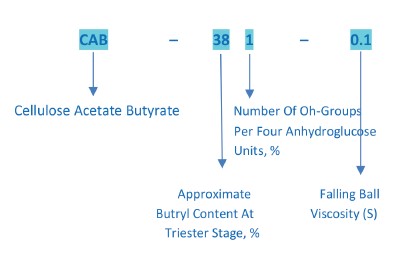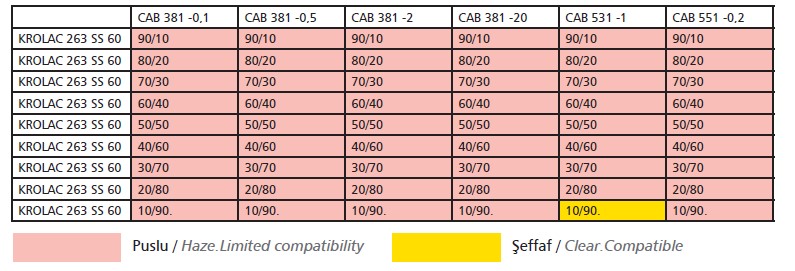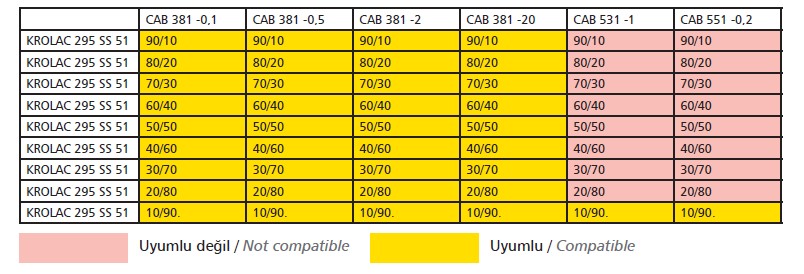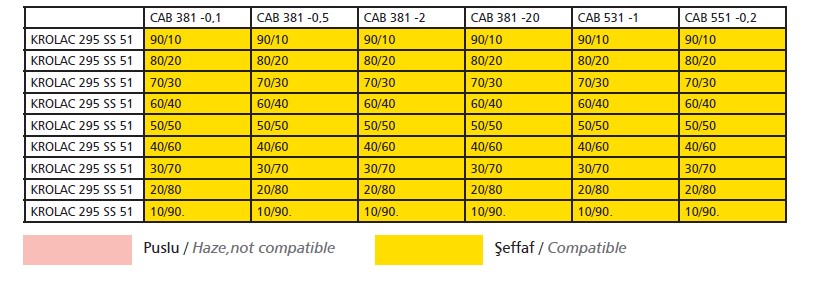1. Cellulose Esters, General Information
1.1 Cellulose Acetate (CA): Usage in coatings formulations is very limited because of low solubility in the common coating’s solvents and compatibility with common coatings resins.
1.2 Cellulose Acetate Propionate (CAP): Cellulose ester with improved solubility and compatibility; especially preferred in low-odor requirement applications in coatings an ink formulation.
1.3 Cellulose Acetate Butyrate (CAB): The most common cellulose ester type used in coatings formulations due to optimized solubility and compatibility.
The code system of Eastman CAB is as given below:

Important physical properties of common CAB esters with respect to coatings formulation principles are listed on Table-1:

According to ASTM D817 (Formula A) and D1343
Glass transition temperature, °C
2) Advantages of Cab Usage in the Formulation
Addition of CAB ester to the formulation between 1%-50% solid resins by weight depending on the targeted benefit give following advantages:
•Control of viscosity & dilution ratio,
•Control of physical drying speed,
•Sagging control,
•Intercoat adhesion,
•Permanent crosslinking of CAB with the thermosetting coating resin system due to OH functionality which means better physical and chemical resistances,
•Higher solvent resistance,
•Control of orientation of effect pigments,
•Better and early block resistance,
•Better polishability,
•High UV stability,
•Lower plasticizer migration.
Although, there is no simple and definite rule on the type and amount of CAB addition to the formulation, following guide criteria should be taken into consideration:
•Solvent system used in the coatings formulation,
•Polymer types used in the coatings formulation,
•Expected modified properties of the coating.
3) Solubility
CAB esters are compatible polymers with many common and economical coatings solvents which are soluble in following solvents:
• Esters,
• Ketones,
• Glycol ethers,
• Glycol ether esters,
• Aromatic hydrocarbon and alcohol blends.
Beside these solvent groups, they are tolerant to be diluted by aromatic hydrocarbons and alcohols.
4) Compatibility
The term “compatibility” usually refers to the homogeneity of polymer mixtures in wet phase or transparency and haze free appearance of the dry film of cellulose ester/polymer combination in the formulation.
Sometimes, different laboratories may report different results which may arise differences in solvent combinations, curing conditions and/or dry film thicknesses. For specific applications, each laboratory should make its own test and evaluation.
5) Compatibility Tests –A Model
Following tests were carried out in our laboratories for both mixtures of CAB/Acrylic resin solutions and also dry films of these resin mixtures as a guide and results were reported on tables 2A, 2B, 3A and 3B.
a) CAB esters were dissolved in 99% purity n.butyl acetate in 15% solids,
b) The acrylic polyols to be tested were diluted with 10% additional 99% purity n.butyl acetate,
c) Solutions (a) and (b) were mixed in the ratios from 10/90 mixing ratio to 90/10 mixing ratio by weight and listed on Table 2/Table 3 and evaluated for;
• Homogeneity and transparency of the wet mixture,
• Transparency and water white clarity of the dry film of the mixture after applying it at 90 microns wet film thickness on glass, 10 minutes flash off at room temperature and stoving at 80°C/30 minutes.
Results
Have been listed on Table 2A and 2B for KROLAC 263 SS-60 and Table 3A and 3B,
For KROLAC 295 SS 51 respectively.
Table 2A – Wet mixture compatibility results of KROLAC 263 SS-60 with common CAB esters

Table 2A – Dry film compatibility results of KROLAC 263 SS-60 with common CAB esters

Table 3A – Wet mixture compatibility results of KROLAC 295 SS-51 with common CAB esters

Table 3B –– Dry film compatibility results of KROLAC 295 SS-51 with common CAB esters

6) Results
Adding CAB esters to OH functional acrylic resins where amino resins or isocyanate prepolymers are being used as co-reactants to give unique, specific properties to the coating system is a valuable modification technic for the coatings formulator.
Sometimes, different laboratories may report different results regarding compatibility behavior of CAB esters and acrylic resins which may arise differences in solvent combinations, curing conditions and/or different dry film thicknesses. For specific applications, each laboratory should make its own tests and evaluation.
We hope this study will give a simple and practical model to our colleagues in the coatings industry.

Muhammet Demirkıran
Sales Manager
Coatings, Inks and Adhesives Group
Kempro Kimyasal Maddeler ve Dış Tic. A.Ş.





